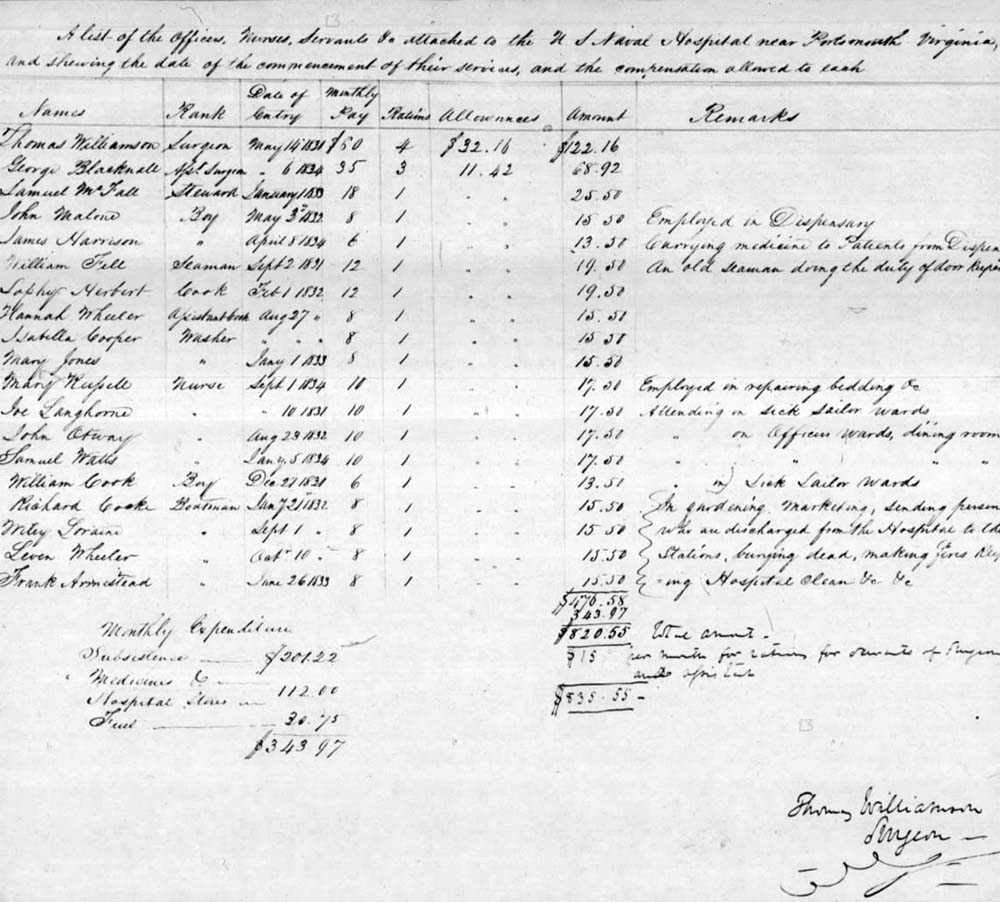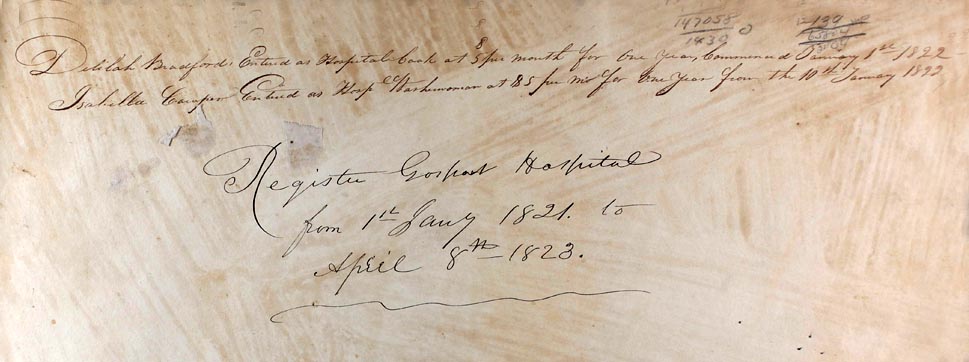SPECIAL TOPICS CONTRIBUTIONS BY JOHN G. SHARP
Gosport Naval Hospital Staff in 1834
Introduction: Established in 1830 Gosport Naval Hospital was the first permanent naval hospital which replaced an older more rudimentary facility. This transcribed 1834 “List of the Officers, Nurses, Servants &c attached to U. S. Naval Hospital near Portsmouth Virginia” provides vital information on the naval medical officers, enlisted personnel, and the civilian employees assigned to the hospital.1 The following is a brief summary of their duties and responsibilities, combined with newly discovered biographical data and information on slavery at Gosport extracted from surviving case files and registers.
Dr. Thomas Williamson, Dr. George Blacknall: Leading the new hospital was Surgeon Thomas Williamson USN (1791-1859). Dr. Williamson had rapidly established himself as an energetic and resourceful naval physician and, except for two tours at sea as fleet surgeon to the Mediterranean Squadron, was from 1831 until 1855, chief surgeon and officer in charge.2 Williamson was ably seconded by Assistant Surgeon Dr. George W. Blacknall (1804 -1862) who later became hospital director.3 Both physicians had labored together during the great cholera epidemic of August and September of 1832. In an undated August 1832 hospital register entry Dr. Williamson wrote, “The cholera prevailed in the United States … The epidemic in Portsmouth started on the 26th day of July 1832 and raged with great violence till the last of August.”4 Williamson later admitted that the cholera, was “the most recent and severe affliction in my family, the anxiety of mind, the fatigue of body inseparable from the situation I hold during the summer & autumn.”5 During the epidemic, Williamson, Blacknall, and the hospital staff were “working all hours, and encountered great fatigues” in their efforts to check the ravages of the disease and allay public fear.6 Following the epidemic the pace of Gosport admissions remained high. The medical staff though contacted variety of serious ailments. In 1825 Dr. Williamson was in bed with “bilious fever’ for two weeks.7 Well known physician Dr. Isaac Hulse worked at Gosport in the 1820’s and may have contacted tuberculous there. Dr. Williamson’s case note, related “Dr. Hulse – there is great danger in this case troublesome, with blood…and considerable degree of fever.” Williamson made a full recovery but Dr. Hulse’s tuberculous manifested itself throughout his career.8 The Gosport facility’s excellent reputation and the needs of an expanding fleet meant patient admissions continued and placed significant pressure upon the medical staff. Surviving hospital records confirm that by 1838 Gosport’s new admissions were 320 a year of the long-term chronically ill.
Dr. Williamson and Smoking: Today Dr. Thomas Williamson is best known for his farsighted 1838 “Rules for the government of this hospital.” Most of the twenty-six regulations reflect Williamson’s concern for the role and authority of the medical officer, the care of patients, hospital sanitation, and hygiene. As Dr. Joseph Alsop has recently pointed out, “Williamson’s regulations attempted to provide a framework for the humane treatment of incapacitated servicemen.” Rule number 20 reads: “No smoking is allowed in any Hospital building or precincts, except that part of the basement story in the rear of the Court Yard, which will be pointed out by the Medical Officer.” This regulation was a first, and established a significant precedent for all naval hospitals. Williamson’s limitation on smoking is the earliest restriction on smoking to be uncovered for the United States Navy. The new smoking regulation ran contrary to the popular lore of the 1830’s which considered smoking a preventive against cholera and other so called “miasmatic” or airborne disease.9 It was not until 1854 that London physician, Dr. John Snow first identified cholera as water born. The same year Italian anatomist Dr. Filippo Pacini isolated the infectious bacterium Vibrio cholerae as the cause of cholera.10 Dr. Williamson’s actual motivation in adopting this rule may reflect a concern for fire safety and decorum evident in rules number 19, 22, and 25.11 Dr. Williamson’s practice included a wide range of pulmonary ailments with many officers and sailors suffering respiratory complaints and tuberculosis; he may well have noticed that smoke within the confines of ship or hospital only aggravated their conditions.12
The Hospital Staff: Regulation number 2 stated that “The Steward, Nurses, attendants and all others attached to the Hospital were to be considered as belonging to the service …” This regulation was Williamson’s attempt to maintain administrative control of the hospital staff and reserve jurisdiction of all discipline and pay disputes to medical officers. In 1834, Gosport Hospital civilian staff worked a six-day week and a twelve hour day. At the Gosport Hospital most of the staff ate (victualled) at the hospital and some such as the Steward probably lived on the grounds.
The Steward: The exact date Samuel McFall came to the hospital is unknown, though he is listed as Hospital Steward as early as 1825. McFall helped both with clerical tasks and the supervision of non-medical staff such as the cooks and the boatmen. Samuel McFall, who was white, was payed $18.00 per month plus allowances and usually lived at the hospital. The previous Hospital Steward had been accused of corruption.13 Regulation 16 stated, the Hospital Steward was charged with keeping the patients clean and well clothed and to make sure their clothes were frequently washed.
Five Women: This 1834 payroll lists four female civilian employees: Isabella Cooper, Sophy Herbert, Hannah Wheeler, and Mary Jones. The fifth female employee is an enslaved washerwoman, Fanny (surname unknown) given prominent mention in the 1825-1826 case files. These are some of the first Gosport Naval Hospital women for which we have records. While no race is provided on early naval payroll or musters, the Case Files from 1825-1826, make it plain these five women were African Americans and enslaved.14 The entry dates on the 1834 payroll are misleading; these dates are not the dates the women went to work at the hospital. For example, Isabella Cooper, hospital washer, was enumerated on 24 August 1825 as the “Washerwoman Isabella…” She is again mentioned on 29 August 1825 when Dr. Williamson placed Isabella on regime of quinine, perhaps for malaria. Another series of entries relates that on 1 September 1825 “Fanny the Washerwoman” was admitted on 2 September 1825; “Fanny in labor – send for a Midwife.” Then on 4 September 1825 an entry reads, “Isabella for duty… Fanny discharged from the hospital and sent to her owner.” Fanny was returned to the slaveholder with her newborn child but after a few months she again appeared in the records perhaps with malaria on 5 April 1826. Her prescription reads “Fanny…Quinine every 2nd hour, if chill comes …” Fanny’s stay in the hospital was not unique; for the Gosport Naval Hospital provided medical care to slaves employed at the navy yard and hospital. The Gosport Hospital Case Papers for 1825-1826 includes entries for both Dr. Williamson’s servant 11 July 1825 and Commodore James Barron’s servant 14 July 1825. Servant was the polite euphemism for slave; neither is mentioned by name. This practice of providing medical care was largely to allay slaveholder’s fears of injury to their "property." The practice officially began in 1813 when the Secretary of the Navy made hospital care as a significant concession to those with slaves at the Washington Navy Yard. This concession was later extended to naval hospitals at Gosport and Pensacola.15 In 1838 the Secretary of the Navy Mahlon Dickerson confirmed practice in a letter to the Pensacola Navy Yard.16
Each year the annual naval appropriation governed employment of all labor free and enslaved. During this era the size of hospital budget determined if and when slaves were hired and placed on the payroll. All slaves, such as Isabella Cooper and Fanny, wages were paid directly to a slaveholder. During this period about one-third of the Gosport workforce was enslaved, most slaveholder’s were navy yard master mechanics or senior journeyman.17 Slaves knew bad as things were, they could be worse. George Teamoh a former Gosport enslaved laborer recalled "Slavery was so interwoven at that time in the very ligaments of the that to assail it from any quarter was not only a herculean task, but on requiring great consideration caution and comprehensiveness." He goes onto say "At that I was occasionally at work in the Navy Yard, and with hundreds of others in my condition felt to remain there rather than being worse situated or sold.”18
The five women worked mainly as support staff. However they were in regular contact with patients on a daily basis and in doing they shared the risk of exposure to such virulent diseases as cholera, yellow fever, influenza, etc. Four of the women worked during the dreadful months of August and September of 1832. That cholera summer they had cleaned and provided meals for dozens of sick and dying sailors and marines. These patients were mostly seamen from the USS Fairfield, Java and the U.S. Marine garrison.19 Sophy [Sophie] Herbert, the hospital cook, was paid $12 per month, and her assistant Hannah Wheeler paid $8 per month. Both women cooked and prepared daily meals for up to one hundred patients and staff. Isabella Cooper and Mary Jones, as washers had the heavy and laborious task of scrubbing and cleaning soiled hospital bedclothes, sheets, and bandages. For Dr. Williamson, cleanliness was important to health, and his regulation (number 16) mandated that every part of the hospital be visited by a medical officer daily and inspected. He stressed all patients be kept clean and well clothed but it was Cooper and Jones who made it possible. Also on the payroll was Mary Russell designated a nurse, though the remarks column implies she worked mainly as a seamstress “Employed repairing bedding etc.”
Boatmen: The hospital employed four boatmen as all round labor. The four are listed as: Richard Cook, Wiley Loraine, Leven Wheeler, and Frank Armistead. These men were most likely African Americans and enslaved. Their wages would have been paid to the various slaveholders. The four men performed a mix of heavy labor noted in the remarks column as: gardening, marketing, sending persons who are discharged from the hospital to their stations, burying the dead, making fires, keeping hospital clean, etc. For the hospital, boats and a trained boat crew were essential for transporting patients from ships in harbor or quarantine to the hospital and to transport medical supplies and groceries. The hospital boats were frequently used by the staff for communication with the navy yard. Safety was important especially from fire. Hospital regulation number 25 specified the boatmen and the nurses were to keep a regular watch at the hospital each night so attention may be given to protect patients and “public property from fire and other accidents.” The boatmen’s duties were to dig graves and move bodies for burial, were important most especially during periods of contagious disease such as the cholera outbreak of 1832. Death was frequent at the hospital. Regulation number 24 required the effects of deceased persons be inventoried typically by hospital steward, Samuel McFall, and that the bodies be handled with “solemnity, decorum” in burial details.
Nurses: In the 1830’s military hospitals typically employed untrained, men and women as nurses. For much of the nineteenth century nurses were accorded lowly status by both the medical profession and society at large. The three male nurses are listed as Joe Langhorne, who worked in the enlisted wards, and John Otway and Samuel Walls who cared for the officers. These three men were also most likely African Americans and enslaved. Like the women some of these enslaved men were probably working at the hospital for many years. One entry confirms this, “Langhorn sent as Gardner etc. to the hospital this 7th day of Novr 1825.” As a slave Langhorne’s wages would have been paid directly to the slaveholder. The slaveholder then gave Langhorne whatever his master considered sufficient to sustain him. The three men worked long hours and were responsible for making beds, feeding and cleaning patients, emptying bed pans, administering medicines, and related tasks.
The Doorkeeper: William Fell first entered the hospital as a patient on 10 May1831 and was discharge on 20 August 1831 and later hired as doorkeeper. Fell is listed as “an old seaman.” As hospital doorkeeper he monitored patient and visitor access, and kept the hospital admittance register. Fell was later entered as patient in June and July of 1838 for a brain seizure, but apparently recovered.
The Boys: Three individual employees are listed as “Boy.” They are John Malone and James Harrison who provided help in the hospital dispensary and carried medicines to patients. The third William Cook assisted on the wards and dining room. At this time “Boy” in the United States Navy was a rank given to young enlisted men 12 to 18 years of age who were in training as seaman. Most “Boys” were usually rated Ordinary Seaman at age 18.
Transcription: This transcription was made from digital images of letters and documents received by the Secretary of the Navy, NARA, M125 “Captains Letters” National Archives and Records. In transcribing all passages from the letters and memorandum, I have striven to adhere as closely as possible to the original in spelling, capitalization, punctuation, and abbreviation, superscripts, etc., including the retention of dashes and underlining found in the original. Words and passages that were crossed out in the letters are transcribed either as overstrikes or in notes. Words which are unreadable or illegible are so noted in square brackets. When a spelling is so unusual as to be misleading or confusing, the correct spelling immediately follows in square brackets and italicized type or is discussed in a foot note. The names of all naval ships are italicized .John G. Sharp, 6 March 2019
================================
List of the Officers, Nurses, Servants &c attached to U. S. Naval Hospital near Portsmouth Virginia, and shewing the date of the commencement of their services, and the compensation allowed to each
Names Remarks Thomas Williamson - - George Blacknall Asst Surgeon
- - Samuel McFall - - John Malone Employed in Dispensary James Harrison Carrying medicine to patients from Dispensary William Fell An old seaman doing the duty of Door Reports Sophy Herbert - - Hannah Wheeler - - Isabella Cooper - - Mary Jones - - Mary Russell Employed in repairing bedding &c Joe Langhorne Attennding in Sick Sailor Wards John Otway On Officers Wards, dinning room Samuel Walls On Officers Eards, dinning room Willian Cook On Sick Sailors Wards, dinning room Richard Cook *Note Wiley Loraine - - Leven Wheeler - - Frank Armistead - - *Note 1 re W. Cook, R. Cook, Loraine, Wheeler and Frank Armistead: “In Gardening marketing, sending persons who are discharged from the Hospital to their Stations, burying the dead, making fires keeping Hospital Clean &c &c”
Note 2 "What Amount-per month for servants of surgeon and assistant surgeon.”
Monthly Expenditure
Subsistence $201.22 $476.58
Medicines 343.97
Hospital 112.00 $820.55
Fee 30.75 $15*
$343.97 $835.55
**Entire amount per month for rations of surgeon and assistantThomas Williamson, Surgeon
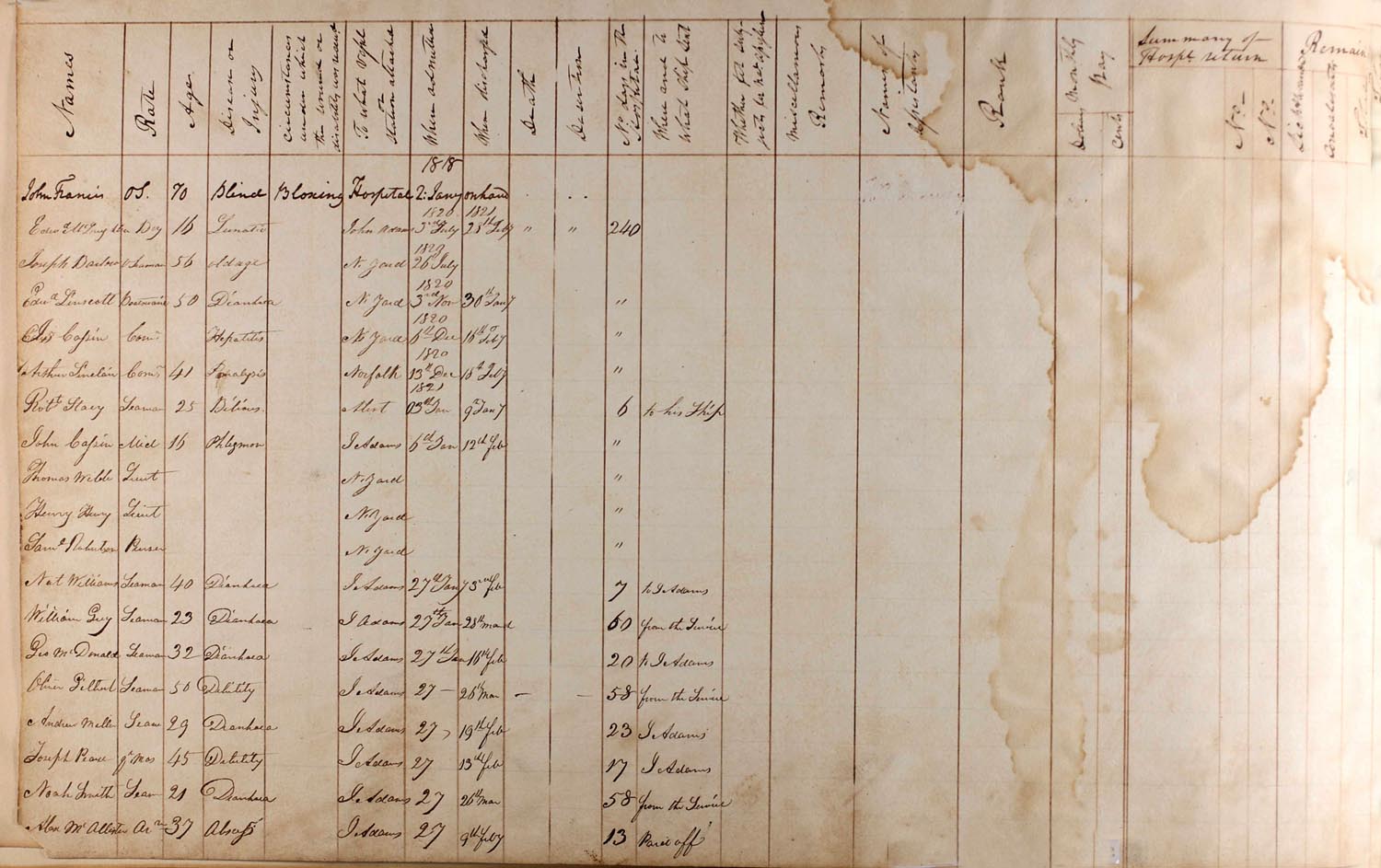
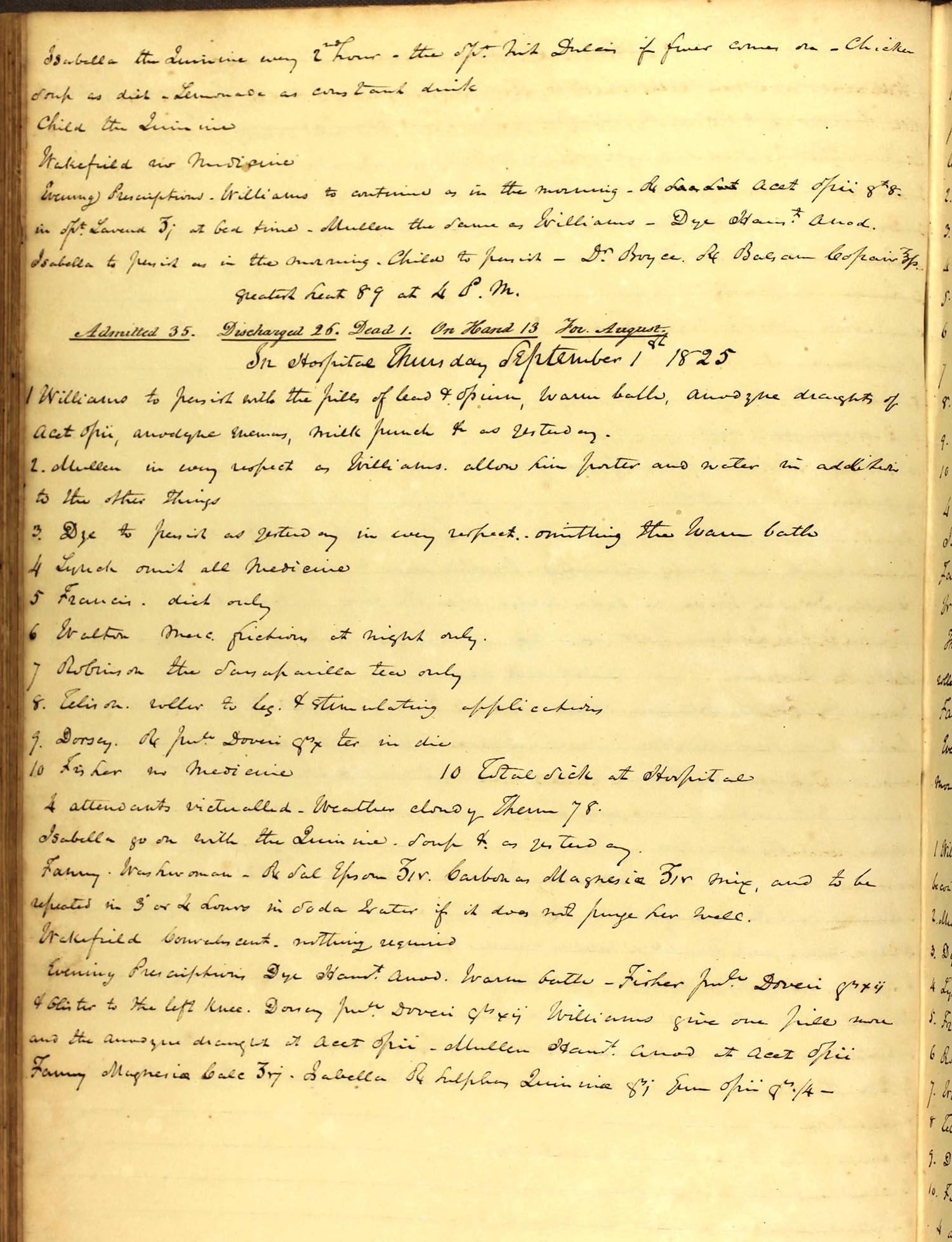
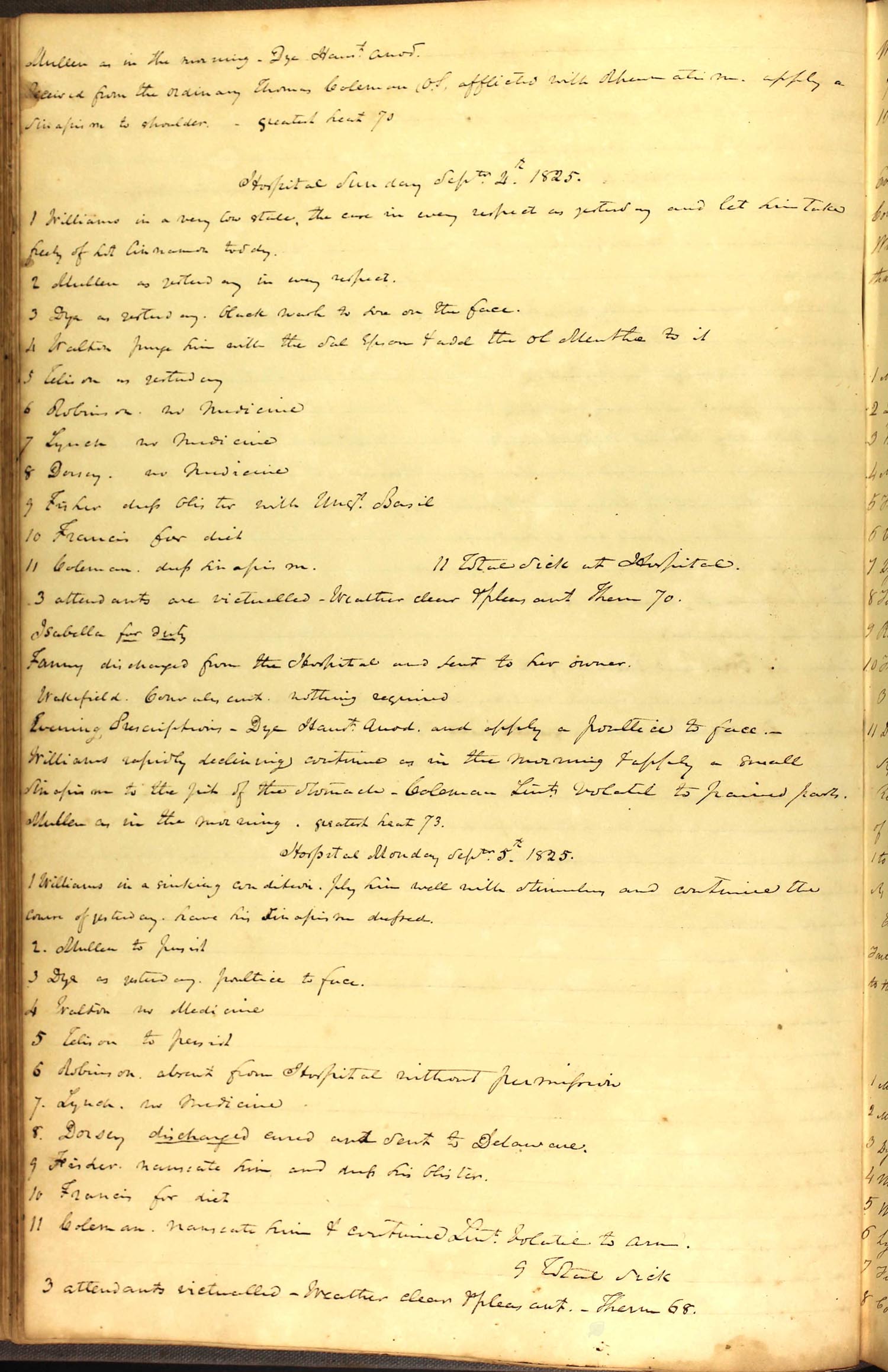
IM 1 Nov 1820 Gosport Naval Hospital patient list
IM 2 September 1, 1825, Hospital admissions and treatment prescribed
IM 3 September 4, 1825, Hospital patients and their progress
"Fanny" the washer woman admitted for treatment on the 1st and discharged on the 4th and sent back to owner
IM 4 Entrance on duty of two female slaves Delilah Bradford as hospital cook pay $5 per month and Isabella Cooper as hospital washer woman Isabella was also entered fro one year starting Jan 1822 and pay $5 per year. In the antebellum period in southern, slaves such as Delilah and Isabella were rented out typically in January for one year periods. Their pay of course went to the slaveholder, but they usually were given some small allowance as incentive. The Gosport hospital records mention Isabella frequently but this is our only mention of Delilah.
Endnotes
1 Miscellaneous Records of the Navy Department Payrolls Gosport, Virginia 1834 roll 0015
2 James Alsop, Research Note: The Code of Regulations for the First U.S. Naval Hospital, Norfolk, Virginia, 1838 Northern Mariner /Le marin de nord 59-67 https://www.cnrs-scrn.org/northern_mariner/vol21/tnm_21_60-67.pdf accessed 21 February 2019. My discussion of Dr. Thomas Williamson is based primarily on Dr. James Alsop’s article in the Northern Mariner. Dr. Alsop was the first to publish and analyze these precedent setting regulations
3 George Blacknall was born in North Carolina on 13 September 1804. He entered the United States Navy as a Surgeon’s Mate, on 3 January, 1828, and became a Passed Assistant Surgeon, 3 March, 1835. He was promoted to Surgeon, 9 February, 1837, Dr. Blacknall resigned his naval commission on 7 May, 1861, joined Confederate States Navy as Surgeon, and he died in Norfolk on 20 January 1862.
4 NARA RG -52 Cases Files for Patients at the Naval Hospitals, and Registers 1812 -1829, Gosport, 1832, 10 – Remarks, Dr. Williamson’s comments adjoin page 10. This page enumerates twenty patients from the USS. Fairfield, USS Java and the Gosport marine garrison all suffering from cholera.
5 Thomas Williamson to Mahlon Dickerson 15 October 1834 “Whom I have known… and more particularly during the cholera here …” 2nd quote, Williamson to Dickerson 10 December 1832
6 Warrington to Levi Woodbury 7 August 1832.
7 Gosport Files and Case Papers 6 September 1825
8 Gosport Files and Case Papers 11 July 1825. Dr.Isaac Hulse Surgeon USN was born near Coram, Suffolk County, Long Island New York, on August 31, 1797. He graduated from the University Maryland Medical School where he met and married, Amelia Roberts in 1821. Dr. Hulse joined the United States Navy on May 12, 1823. His first assignment was that of Surgeon’s Mate aboard the U.S.S. Congress based in Norfolk, Virginia. His voyages aboard the USS Congress in the following year, took him to Gibraltar, Cadiz, Rio de Janeiro, the West Indies and the west coast of Africa. Back in the United States in 1821 Dr. Hulse was assigned to the Naval Hospital at Norfolk, Virginia, where he remained for two years during and was promoted to Surgeon. In 1826 Hulse was assigned to Naval Hospital Pensacola Florida. In August 1827 his wife Amelia died while on the return voyage from Pensacola to New York and was buried at sea. In contrast to his colleagues, Dr. Hulse had requested this most arduous and dangerous assignment. At Barrancas he rented two a story dwelling as a hospital and attempted to bring quality medical care to a hard pressed military community. On 10 January 1833 Hulse married Melania Innerarity daughter of John Innerarity a wealthy planter and one of the largest slaveholders in the county. Hulse spent considerable time urging the construction of new purpose built hospital (he was particularly keen to move the hospital and his patients from the tempting local grog shops) but because of military construction funding delays, the Naval Hospital was not completed until December 1835. His monograph on “Yellow Fever” was published in the Maryland Medical and Surgical Journal, April 1842. In September 1847 Hulse tragically lost his seven year old daughter Mary Victoria to the dread disease. Surgeon Hulse served as commanding officer of the Pensacola hospital three times, spending 19 of his 33-year Navy career in northwest Florida before his death of tuberculosis on 29 August 1856. He is buried at Barrancas, National Cemetery located on Naval Air Station Pensacola. Today Surgeon Hulse's Naval Hospital at Pensacola enjoys world renown and his reports provide valuable demographic and medical information for historians.
9 Alsop, 66
10 Steven Johnson The Ghost Map The Story of London’s Most Terrifying Epidemic and How it Changed, Cities and the Modern World (Riverhead Books: London 2006), 213
11 Alsop, n. 28
12 For some of Dr. Williamson’s patients see, Williamson to Secretary of the Navy Mahlon Dickerson 3 September 1833, re Midshipman Octavius Fairfax spitting blood and he recommended, Fairfax spend the winter in the south. See also Williamson to Secretary of the Navy, 13 July 1825 recommending a leave of absence for Dr. Isaac Hulse due to “serious pulmonary disease.”
13 Alsop, n.22
14 Todd Lee Savit Medicine and Slavery Diseases and Health Care Among Blacks in Antebellum Virginia (University of Illinois: Chicago 1981), 243
15 Secretary of the Navy W. Jones to Dr. Edward Cutbush dated 23 May1813 RG45 NARA. For examples at WNY see Register of Patients at Naval Hospital Washington DC 1814 With The Names of American Wounded From The Battle of Bladensburg Transcribed with Introduction and Notes by John G. Sharp see note 20 https://www.history.navy.mil/research/library/online-reading-room/title-list-alphabetically/r/register-patients-naval-hospital-washington-dc-1814.html Accessed 5 March 2019 For Pensacola Navy Yard see Floridian and Advocate 10 September 1836, 1 This was an advertisement signed by Commodore W.G. Bolton to Florida slaveholders for enslaved laborers guaranteeing medical care.
16 Secretary of the Navy Mahlon Dickerson to Dr. Solomon Sharp USN 2 June 1838. NARA RG45. Dr. Sharp had questioned the propriety and legality of providing medical care to enslaved labor. The Secretary responded “Sir, I have received your letter of the 17th ultimo, and in reply to it I have to state, that it is not deemed expedient to change the practice which prevails at the Navy Yard Pensacola, of the Surgeon attached to the Yard, giving medical attendance to the persons employed in it. I am respectfully yours &c.” (Signed) M. Dickerson
17 John G. Sharp A Norfolk Navy Yard Slaveholders Petition to the Secretary of the Navy, June 21, 1839 “I beg leave to state, that no Slave employed in this Yard, is owned by a commissioned officer, but that many are owed by the Master Mechanicks & workmen of the Yard - All these without distinction , are & have always been governed by those rules of the Yard, by which other persons, who are mustered, are governed, to wit; that where by reason of rain or other reasons, the mechanicks cannot work , the blacks attached to them, are not allowed to work, except in cases where they can be necessarily employed, in clearing [and ] arranging or stowing away articles which may then be done without inferring with work [illegible] of the Yard – I beg leave to state, that no Slave is allowed to perform any mechanical work in the Yard , all such being necessarily reserved for the whites; this keeping up the proper distinction between the white men & slave - Commodore Lewis Warrington to Secretary of the Navy dated 21 June 1839. http://www.usgwarchives.net/va/portsmouth/shipyard/nnysharp6.html accessed 5 March 2019
18 George Teamoh God Made Man Man Made the Slave: The Autobiography of George Teamoh, edited by F.N. Boney, Richard L. Hume and Rafia Zafar (Macon: Mercer University Press, 1990),84-85
19 John G. Sharp Cholera at Gosport Navy Yard 1832 http://www.usgwarchives.net/va/portsmouth/shipyard/nnysharp5.html accessed 5 March 2019
- - - - - -
John G. “Jack” Sharp resides in Concord, California. He worked for the United States Navy for thirty years as a civilian personnel officer. Among his many assignments were positions in Berlin, Germany, where in 1989 he was in East Berlin, the day the infamous wall was opened. He later served as Human Resources Officer, South West Asia (Bahrain). He returned to the United States in 2001 and was on duty at the Naval District of Washington on 9/11. He has a lifelong interest in history and has written extensively on the Washington, Norfolk, and Pensacola Navy Yards, labor history and the history of African Americans. His previous books include African Americans in Slavery and Freedom on the Washington Navy Yard 1799 -1865, Morgan Hannah Press 2011. History of the Washington Navy Yard Civilian Workforce 1799-1962, 2004.
https://www.history.navy.mil/content/dam/nhhc/browse-by-topic/heritage/washington-navy-yard/pdfs/WNY_History.pdf
and the first complete transcription of the Diary of Michael Shiner Relating to the History of the Washington Navy Yard 1813-1869, 2007/2015 online:
https://www.history.navy.mil/research/library/online-reading-room/title-list-alphabetically/d/diary-of-michael-shiner.html
His most recent work includes Register of Patients at Naval Hospital Washington DC 1814 With The Names of American Wounded From The Battle of Bladensburg 2018,
https://www.history.navy.mil/research/library/online-reading-room/title-list-alphabetically/r/register-patients-naval-hospital-washington-dc-1814.html
The last three works were all published by the Naval History and Heritage Command. John served on active duty in the United States Navy, including Viet Nam service. He received his BA and MA in History from San Francisco State University. He can be reached at sharpjg@yahoo.com
Norfolk Navy Yard Table of Contents
Birth of the Gosport Yard & into the 19th Century
Battle of the Hampton Roads Ironclads
The Norfolk Navy Yard into the 20th Century
